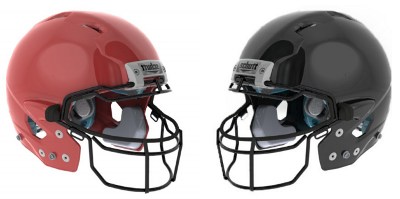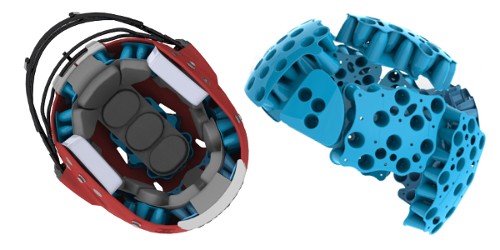 |
| September 11, 2012 | Volume 08 Issue 34 |
Designfax weekly eMagazine
Archives
Partners
Manufacturing Center
Product Spotlight
Modern Applications News
Metalworking Ideas For
Today's Job Shops
Tooling and Production
Strategies for large
metalworking plants
Engineer's Toolbox:
Football helmet maker whips product line into shape with ReverseEngineering.com and SolidWorks software

Schutt Sports used ReverseEngineering.com's software integrated directly into SolidWorks to take point clouds from a digitizer in real time and convert them directly into native parametric CAD models, a process that turned real football helmets into 3D computer models so that designs could be improved.
Do you want to be safe, or do you want to be cool on the field?
Too often, these are mutually exclusive options, but not in the case of the world's leading football helmets and faceguards. Three out of four pro football players wear Schutt Sports gear. The Litchfield, IL, company's Ion 4D, Schutt AiR XP, and DNA Pro+ are the world's only helmets to feature advanced TPU cushioning, the material used in U.S. fighter-pilot and paratrooper helmets. Safe and cool, these helmets protect heads and look good doing it. Though a rising star, Schutt Sports has made football safety equipment since 1935, when it developed the sport's first faceguard. The company decided to aggressively upgrade its entire helmet and faceguard line last season, a decision that presented several engineering challenges.
Recovering complex surfaces from 2D designs
First was complexity. Hardly spherical, a football helmet has a complex set of curves to optimize safety, fit, performance, and eye appeal. Adding to this complexity are cooling vents for comfort and prevention of heat stroke. Second, Schutt's engineering documents were trapped in static 2D files, presenting a major productivity hurdle for engineers used to the speed and power of their 3D modeling software from Dassault Systemes SolidWorks Corp.
"We needed a straightforward way to get our existing, older designs into a 3D format so we could update them," says Tony VanHoutin, Schutt's lead design engineer. "We could not compromise on precision because we need a perfect fit of all helmet components, including shells, padding, faceguards, and fasteners across our full range of child and adult sizes."
The traditional method for converting products with complex shapes into 3D models is using calipers, tape measures, and micrometers to get measurements; plugging the dimensions into spreadsheets; and keying these dimensions into CAD models. Accuracy requires a lot of measurements, high-level spatial abilities, specialized engineering expertise, many professional staff hours, and a lot of luck.
Solution: Digitization
Schutt engineers determined that digital scanning was the best solution. The company purchased an affordable desktop 3D coordinate measurement machine (CMM) digitizer from FARO Technologies -- essentially a wand you run over the contours of an object to capture the surface data. This solution removed the complexity of extrapolating discrete measurements into complex surface shapes. Digitization tools, however, typically create an ASCII point cloud of x, y, and z geometric data. In order to import the data into CAD software, it's converted into the industry-standard IGES data exchange format. That file is then converted, by a second IGES translator, into the CAD software's native file format. This multistep translation into and out of IGES is only as reliable as the software code in the translators. Too often, errors pile up over several conversions, and features that are scanned become corrupted before they reach the CAD model.
The value of native translation
Fortunately, Schutt discovered ReverseEngineering.com, whose reverse-engineering product can take a point cloud from a digitizer in real time and convert it directly into a native parametric CAD model, in this case a SolidWorks SLDPRT file. ReverseEngineering.com transforms SolidWorks software into a dynamic digitizing platform, accurately conveying points, open lines, closed lines, open splines, closed splines, circles, arcs, rectangles, and more.
"We just run the stylus over the 'old' helmet, and it appears as a fully operational fully parametric SolidWorks model with none of the mistakes, compromises, or limitations of geometry run through the IGES format," says VanHoutin. Once the model is in SolidWorks software, VanHoutin's team can modify, update, and elaborate on the design with ease. "What would take weeks with rulers, Excel, IGES translations, and file repairs takes a few minutes with the desktop 3D CMM digitizer, ReverseEngineering.com, and SolidWorks," says VanHoutin.

Advanced TPU cushioning in Schutt helmets provides superior impact absorption, heat management, and hygenics.
Schutt is using SolidWorks as its CAD tool because of its combination of ease of use and power. It intuitively handles all the surfaces of the pre-existing helmets and makes it simple for VanHoutin's team to improve on them for its next generation of helmets. "SolidWorks is user friendly, but it's just as powerful as more expensive and complicated software," VanHoutin says. "It handles all the complex organic surfaces. There's nothing I can't do with it."
Additional applications mean more value
As a SolidWorks Certified Gold Product, ReverseEngineering.com software is integrated directly into SolidWorks, creating a single-window consolidated environment providing full access to both software products, yet treating them as one.
In addition to converting old designs into 3D models, the team can turn one-off custom designs, like the helmet they made for Super Bowl-winning quarterback Eli Manning, into standard product offerings. Engineers simply digitize the custom helmet, incorporate it into a SolidWorks CAD model, and mass-produce it, netting the same weeks-to-minutes savings. This reverse-engineering process is also standard for the development of new stainless steel, carbon steel, and titanium faceguard configurations.
Schutt also uses ReverseEngineering.com's software for inspection. When Schutt engineers receive a helmet or faceguard from a new mold, they digitize it into SolidWorks and compare the actual product to the CAD design. Schutt avoids weeks of scrap, rework, and redesign and thousands of dollars in potential costs.
"We're eliminating time, cost, and risk at every step," explains VanHoutin. "With the ReverseEngineering.com and SolidWorks software combination, we're capturing data quickly, we're avoiding the errors of translation, and we're verifying, from the earliest possible moment, that what we make is actually what we designed. That's good for our business and, most importantly, good for our athletes."
Find out more about the companies in this story by clicking below.
Published September 2012
Rate this article
View our terms of use and privacy policy
